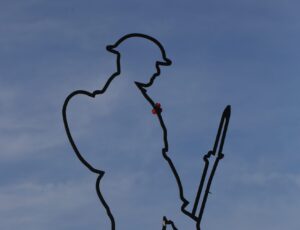1 April 2021
A Foreign Field
By William Morton
 Islington Council put up signs in the borough’s streets at the time of the commemoration of the centenary of the end of the First World War, giving the names of those who had lived in each street and had been killed in the War. The signs are not as grim as the memorials you see in French villages with the names of numerous members of the same family on them but they are sobering enough. There is the sheer number of deaths. One sign, admittedly in a long road, has 24 names on it. There are the brothers both killed at the age of 21 in 1917 and 1918 respectively. Nearly every theatre of the war is represented with men killed in Greece, Turkey and Iraq as well as France and Belgium.
Islington Council put up signs in the borough’s streets at the time of the commemoration of the centenary of the end of the First World War, giving the names of those who had lived in each street and had been killed in the War. The signs are not as grim as the memorials you see in French villages with the names of numerous members of the same family on them but they are sobering enough. There is the sheer number of deaths. One sign, admittedly in a long road, has 24 names on it. There are the brothers both killed at the age of 21 in 1917 and 1918 respectively. Nearly every theatre of the war is represented with men killed in Greece, Turkey and Iraq as well as France and Belgium.
A striking number, particularly younger men, were killed in the summer and autumn of 2018, presumably the result of the final Allied offensive which ended the War and began on 8th August with the battle of Amiens. One cannot help thinking, perhaps somewhat illogically, what bad luck it was on those who died in October and November. Only a few more days and they would have survived. Perhaps for this reason, the death of somebody named on the sign in my own road has particularly caught my attention. Not only did Albert Strasman die, aged 29, of wounds on Armistice Day, 11th November 1918, but this occurred in Russia. How did that come about?
In 1918, the Allies (Britain, Canada, America, Australia, France and Italy) despatched a force to Russia to intervene on behalf of those opposing the Bolsheviks. It landed in Archangel in northern Russia in August 1918. One of the units in it was the 2/10th battalion of the Royal Scots with which Private Strasman was serving. How Strasman, a total Londoner, ended up in the Royal Scots is not clear but presumably such switching between regiments was common. Previously, he had been with the West Kents and the Queens Own Hussars. It is possible that he had been in the army since the War began but I have not been able to verify this. The 2/10th were a second-line battalion and not intended for active service overseas with many men listed as only suitable for garrison duties. It had spent virtually the whole time since its formation in 1914 on coastal defence duties around Berwick on Tweed. It was also a cyclist battalion and part of the Army Cyclist Corps. It sounds odd to modern ears but bicycle infantry were used throughout the War with infantry divisions often having cyclist companies. Complete units of the Corps were not sent overseas. Instead, groups of men were detached. With that background, it is remarkable that the battalion was selected for the Russian expedition but manpower must have been short, particularly given the major offensive in France at the time.
On the force’s arrival in Archangel, the Royal Scots, supported by gunboats, were sent south following the line of the Dvina river. Their first contact with the Bolsheviks occurred on 6th September. On 11th November, they were fiercely attacked by the Bolsheviks, who were only beaten back by the Royal Scots, with support from Canadian artillery, after they had suffered heavy losses. The battalion’s losses were 19 dead and 34 wounded. The fierceness of the fighting is indicated by the fact that 3 Military Crosses, 2 Distinguished Service Crosses and 3 Military Medals were awarded to men who had taken part. It is not definite that Strasman was killed in this action. He may have been wounded in an unsuccessful attack the battalion had made at the end of October and then died of his wounds on 11th November.
There is an Allied Cemetery at Archangel and Strasman is commemorated there. The memorial covers those who died during the campaign and were buried elsewhere. It seems likely that Strasman was buried on the banks of the Dvina a considerable distance from Archangel – in a foreign field and a long way from Islington.
The Allies realised in 1919 that they were achieving nothing in northern Russia and all British units were withdrawn from Archangel by the end of September 1919.
Tile image formed from a photo by Rob Pumphrey at Unsplash


